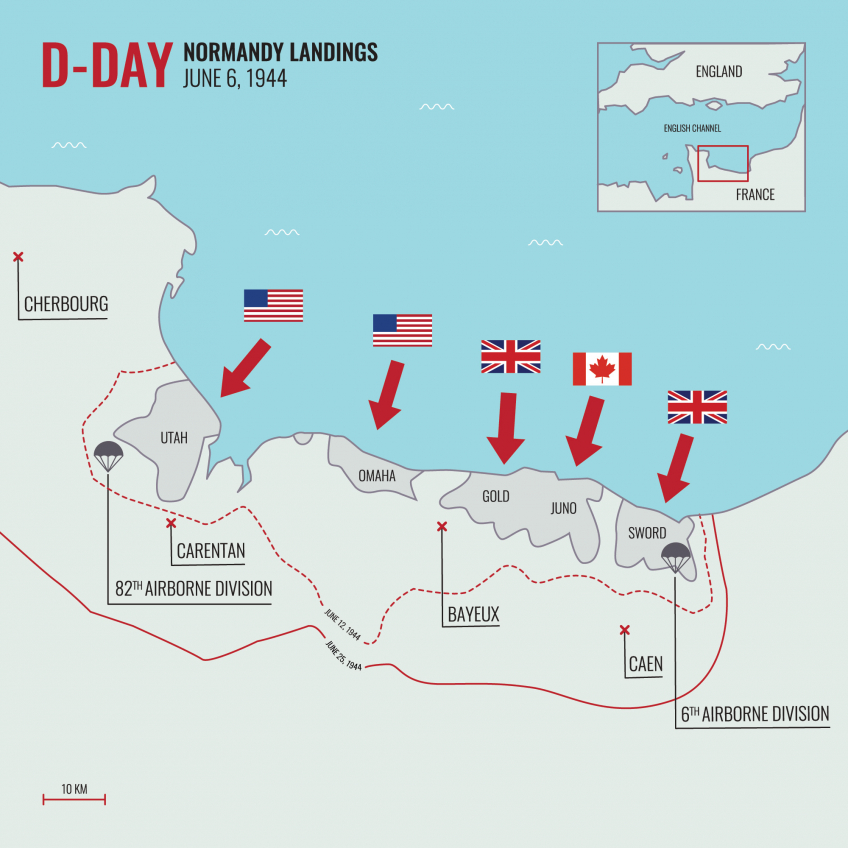What Happened on D-Day?
D-Day, officially known as Operation Overlord, was the largest amphibious invasion in history and marked the beginning of the end for Nazi Germany in World War II. The operation took place on 6 June 1944 and involved the landing of Allied forces on the beaches of Normandy, France. The background to this monumental event is rooted in the broader context of the Second World War and the strategic necessities faced by the Allies.
Strategic Context
By 1944, the Allies, comprised primarily of the United States, the United Kingdom, and the Soviet Union, were determined to defeat Nazi Germany. After the successful North African campaign and the subsequent invasion of Italy, it became clear that opening a new front in Western Europe was essential to relieve pressure on the Soviet forces in the East and to hasten the defeat of Germany.
The decision to launch an invasion of Western Europe was solidified at the Tehran Conference in November 1943, where Allied leaders Franklin D. Roosevelt, Winston Churchill, and Joseph Stalin agreed on the necessity of a cross-Channel invasion. The planning and preparation for this invasion, codenamed Operation Overlord, began in earnest.
Planning and Preparation
The planning for D-Day was an enormous and complex undertaking, involving meticulous coordination among the Allied forces. General Dwight D. Eisenhower was appointed as the Supreme Commander of the Allied Expeditionary Force, responsible for overseeing the operation.
Key components of the preparation included:
1. Intelligence and Deception: Operation Fortitude was a critical element of the D-Day strategy, designed to deceive the Germans about the true landing site. The Allies created a phantom army, led by General George Patton, ostensibly preparing to invade the Pas-de-Calais region, the narrowest point between Britain and France. This deception successfully diverted German attention and resources away from Normandy.
2. Logistics and Supplies: The sheer scale of the invasion required vast amounts of supplies, equipment, and troops. The Allies amassed over 2 million soldiers in the UK, along with thousands of tanks, aircraft, and ships. Mulberry harbours, portable temporary harbours, were constructed to facilitate the rapid offloading of cargo onto the beaches.
3. Training and Rehearsals: Extensive training and rehearsals were conducted to ensure that the troops were prepared for the complexities of amphibious warfare. Exercises like Operation Tiger, although marred by a tragic German attack, were crucial for refining the invasion plans.
4. Air and Naval Superiority: Securing control of the skies and seas was essential. The Allies conducted extensive bombing campaigns to disrupt German supply lines and communications, and the Royal Navy and Allied navies worked to clear the English Channel of mines and protect the invasion fleet.
The Events of D-Day
The Night Before
The invasion began in the early hours of 6 June 1944. Paratroopers from the American 82nd and 101st Airborne Divisions, along with British and Canadian airborne units, were dropped behind enemy lines to secure key objectives and disrupt German defences. These operations were fraught with difficulties, including poor weather and navigational errors, leading to scattered drops. Despite these challenges, the paratroopers succeeded in capturing important bridges and roadways, paving the way for the amphibious assault.
The Landings
The main amphibious assault commenced at dawn, with landings on five beaches along the Normandy coast, each assigned to different Allied forces:
1. Utah Beach: The westernmost landing site was assigned to the American 4th Infantry Division. Despite being off-course, the troops encountered relatively light resistance and quickly secured the beach.
2. Omaha Beach: The American 1st and 29th Infantry Divisions faced fierce German defences, resulting in heavy casualties. The high bluffs overlooking the beach were heavily fortified, and it took several hours of intense fighting for the Americans to gain a foothold.
3. Gold Beach: Assigned to the British 50th Infantry Division, the landings at Gold Beach were met with strong resistance but were ultimately successful. The British managed to advance inland and capture the seaside town of Arromanches, where one of the Mulberry harbours was later established.
4. Juno Beach: The Canadian 3rd Infantry Division faced rough seas and heavy defences, but they fought their way ashore and pushed inland, securing key positions.
5. Sword Beach: The easternmost landing site was the responsibility of the British 3rd Infantry Division, supported by commandos. They achieved their objectives, including linking up with airborne forces and advancing towards Caen.
The Aftermath
By the end of D-Day, the Allies had established a tenuous but crucial foothold in Normandy. Over 156,000 troops had landed, supported by thousands of vehicles and tons of equipment. Despite the significant successes, the cost was high: approximately 4,414 Allied soldiers were killed, with thousands more wounded or missing. German casualties were also substantial but less well-documented.
The successful landings marked the beginning of a brutal and protracted campaign in Normandy, characterised by fierce fighting in the bocage (hedgerow) country. The Allies faced determined German resistance, but the establishment of a secure beachhead allowed for the steady influx of reinforcements and supplies.
Significance and Legacy
D-Day was a turning point in World War II. It marked the beginning of the liberation of Western Europe from Nazi occupation and demonstrated the power of Allied cooperation and coordination. The invasion also underscored the importance of planning, deception, and the element of surprise in military operations.
The success of D-Day laid the groundwork for the subsequent Allied advances into France and ultimately into Germany. Paris was liberated in August 1944, and by the spring of 1945, Allied forces had crossed the Rhine and were advancing into the heart of Germany.
The legacy of D-Day endures as a testament to the bravery and sacrifice of those who participated in the operation. It is commemorated annually, and the beaches of Normandy have become a place of pilgrimage and remembrance, honouring the soldiers who fought and died for the liberation of Europe.
Shortlist
- Your Shortlist is empty

